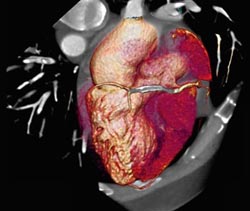Minimal Exposure for Outstanding CT Images

<br>
CT scanners are equipped with one or two X-ray tubes that rotate around the patient. A detector is positioned opposite each tube. Bones and body tissue attenuate X-rays to different degrees. The detectors register the X-rays and transform them into digital signals. The results are high-resolution CT images.
The new Stellar detectors can generate images of even higher quality than was previously the case, even if lower X-ray dosages are used. As a consequence, a Stellar-equipped scanner such as the Somatom Definition Flash can, for example, make a complete scan of the heart in less than one-third of a second and still achieve a resolution of 0.30 millimeters.
What's more, the exposure to radiation is significantly reduced. Thanks to the short scanning times, patients can be examined without having to take beta blockers that lower their heart rate. Obese people can also be examined more easily as the Stellar detectors provide good images even if the X-ray signals are extremely attenuated by thick layers of fat tissue. The same applies to scans made with extremely low doses of radiation, such as those used to examine children and pregnant women.
The key to achieving such a high level of sensitivity is an all-new detector technology that almost totally eliminates the “noise” of the electronic components. The CT detector contains scintillator crystals that first convert the incoming X-rays into visible light.
Photodiodes then convert the light into an analogue electrical signal, which is subsequently digitized. The digital data is used to create cross-sectional images without any overlap. The length of the electrical connection between the analogue components influences the signal-noise ratio and thus the detector's sensitivity. It was decided to reduce the length of the cables, which are only a few centimeters long, to a minimum. To this end, in conjunction with Siemens' global research unit Corporate Technology and the microchip manufacturer AMS, Siemens Healthcare developed a chip with an integrated circuit as well as photodiodes and analogue-digital converters. The new detector is not only more sensitive than previous systems but also consumes 80 percent less energy.
Siemens is equipping all of the new CT scanners from the Somatom Definition Flash and Somatom Definition Edge series with Stellar detectors. Older Somatom Definition Flash and Somatom Definition AS scanners can be retrofitted.
Media Contact
More Information:
http://www.siemens.com/innovationnewsAll latest news from the category: Medical Engineering
The development of medical equipment, products and technical procedures is characterized by high research and development costs in a variety of fields related to the study of human medicine.
innovations-report provides informative and stimulating reports and articles on topics ranging from imaging processes, cell and tissue techniques, optical techniques, implants, orthopedic aids, clinical and medical office equipment, dialysis systems and x-ray/radiation monitoring devices to endoscopy, ultrasound, surgical techniques, and dental materials.
Newest articles

Silicon Carbide Innovation Alliance to drive industrial-scale semiconductor work
Known for its ability to withstand extreme environments and high voltages, silicon carbide (SiC) is a semiconducting material made up of silicon and carbon atoms arranged into crystals that is…

New SPECT/CT technique shows impressive biomarker identification
…offers increased access for prostate cancer patients. A novel SPECT/CT acquisition method can accurately detect radiopharmaceutical biodistribution in a convenient manner for prostate cancer patients, opening the door for more…

How 3D printers can give robots a soft touch
Soft skin coverings and touch sensors have emerged as a promising feature for robots that are both safer and more intuitive for human interaction, but they are expensive and difficult…





















